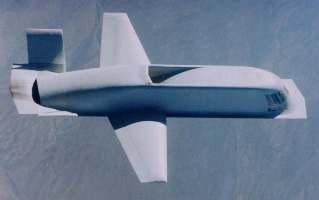STEALTH AIRCRAFT

The US Air Force, Defense Advanced Research Projects Agency, and Northrop Corp. teamed up for the TACIT BLUE Technology Demonstration Program from 1978 to 1985. TACIT BLUE validated a number of innovative stealth technology advances. Most notably, it was the first aircraft to demonstrate a low radar cross section using curved surfaces, along with a low probability of intercept radar and data link.
TACIT BLUE initially was created to demonstrate that a low observable surveillance aircraft with a low probability of intercept radar and other sensors could operate close to the forward line of battle with a high degree of survivability. Such an aircraft could continuously monitor the ground situation behind the battlefield and provide targeting information in real-time to a ground command center.
TACIT BLUE was one of the most successful technology demonstrator programs in Air Force history, meeting all program objectives and most low observable and sensor performance goals. The aircraft made its first flight in February 1982, and subsequently logged 135 flights over a three year period. The aircraft often achieved three to four flights weekly and several times flew more than once a day.
TACIT BLUE featured a straight, tapered wing with a Vee tail mounted on an oversized fuselage with a curved shape. It had a wingspan of 48.2 feet and a length of 55.8 feet and weighed 30,000 pounds. A single flush inlet on the top of the fuselage provided air to two high-bypass turbofan engines. TACIT BLUE employed a quadruply-redundant, digital fly-by-wire flight control system to help stabilize the aircraft about the longitudinal and directional axes.
The TACIT BLUE program cost approximately $165 million and covered development, construction and flight test. As the prime contractor, Northrop received a $136 million contract to provide one complete technology demonstrator and a partially-developed back-up airframe. The program provided valuable engineering data that aided in the B-2 "Spirit" design.
Orignal press release:
Air Force Unveils TACIT BLUE Stealth Aircraft
AIR FORCE UNVEILS STEALTH TECHNOLOGY DEMONSTRATOR
Release No. 01-04-96
April 30, 1996
Washington DC -- The Air Force announced today one of its most successful technology demonstration programs when it unveiled "TACIT BLUE"; an aircraft which provided valuable engineering data and validated innovative stealth technology advances that aided in the B-2 design, as well as other platforms. The once highly-classified program ran from 1978 to 1985 and was unveiled today because the technologies and capabilities are currently in operational use and knowledge of the program no longer needs protection.
The team included experts from the United States Air Force and Defense Advanced Research Projects Agency. The program cost approximately $165 million and was executed under a contract to Northrop Corp. as the prime contractor. TACIT BLUE was developed and tested at several different locations and flown by both Air Force and contractor pilots.
"TACIT BLUE was a leading edge program that took innovative stealth technologies out of laboratory and onto the flightline. The team of professionals who worked on this successful program serve as an example of the what can be achieved when industry and government work together," said Arthur L. Money, Assistant Secretary of the Air Force (Acquisition).
TACIT BLUE featured a straight, tapered wing with a "Vee" tail mounted on an oversized fuselage with a curved shape. It had a wingspan of approximately 48 feet and a length of 55 feet and weighed 30,000 pounds. A single flush inlet on the top of the fuselage provided air to two high-bypass turbofan engines. Only one complete airframe was ever flown, although a second airframe shell was constructed to serve as a backup.